Minneapolis Pioneers and Soldiers Memorial Cemetery and the anti-slavery movement; the Laymans Legacy
The Richey family notes provided by Nancy Okeefe mention that the Layman family was involved in starting a cemetery known as the Layman Memorial Gardens. This information led us to discover the following remarkable and enriching story.
We don't often associate cemeteries with political movements, but the connection between Minneapolis Pioneers and Soldiers Memorial Cemetery and the anti-slavery movement is undeniable.i Our Minnesota Laymans had emerged from there Eastern Lutheran roots as pioneer Baptists and abolitionists. This influenced their mandate for the cemetery. From its inception, the cemetery was a place where anyone of any race or social class could be interred. As such the institution forms the legacy of Dorothy Womack’s maternal great grandfather who founded and supervised it over 20 years. Martin Layman was laid to rest in Layman's Cemetery. Three months later, his wife, Elizabeth, passed away on November 2, 1886 and laid to rest beside her husband.
historic “Greek Revival” Caretakers Cottage
On June 2, 2002, Pioneers and Soldiers Memorial Cemetery became one of the few cemeteries to be placed on the National Register of Historic Places. It received its historic designation for two primary reasons: architectural and sociological.
The cemetery has several distinctive architectural features including the caretaker’s cottage built of limestone blocks which dates from about 1871. ii Other decorative structures, such as the flag pole, the fence and gates, and monuments to territorial women and military veterans date from the 1920’s and 30’s.
The second reason the cemetery is placed on the National Register of Historic Places is the significance of the contributions of those buried in the cemetery to the social history of Minneapolis. For many years this was the only cemetery in Minneapolis on the west side.iii
Mothers’ Monument Made from “Rescued” Stone
Abraham Lincoln is undoubtedly our most frequently quoted president. One of his quotes, though certainly not his most famous, is on permanent display in Minneapolis Pioneers and Soldiers Memorial Cemetery on a memorial dedicated to Minneapolis’ Pioneer Mothers. The memorial is an unusual one, consisting of nothing more than a bronze plaque mounted on a large granite boulder. Beneath the image of a prairie schooner are these words of Abraham Lincoln’s-“All that I am, or hope to be, I owe to my angel mother.” The sentiment is an old-fashioned one, but then Abraham Lincoln was the son of a pioneer mother. The idea for creating a permanent memorial to the women who settled the West belonged to Nellie Hardy.
|
"Layman's Cemetery" started with a single charitable act
The Pioneers and Soldiers Memorial Cemetery in Minneapolis, Minnesota, was originally known as Layman's Cemetery. In 1855 there was a death near Mr. Layman's, and the family having no land, Mr. Layman gave them a corner, now Cedar avenue and Lake street, for a burial place, and "Uncle Wardell" was thus the first person to be laid away there.
In 1859 a half-acre was laid out by Mr. Layman as a family lot and for the accommodation of the neighbors. The following year he platted ten acres, under the name of the Minneapolis Cemetery. In 1871 ten acres were added and again in 1886, just before he died. An addition of seven acres more brought the cemetery to twenty-seven acres that contain 20,000 graves.
This legacy of our Layman ancestors is the oldest existing cemetery in Minneapolis. The cemetery has been the final resting place of those who helped shape the history of early Minneapolis.iv Colonel John Stevens, is widely regarded as the founder of Minneapolis. His daughter, the first white child born in Minneapolis, was buried in the family lot in this cemetery.
Among the other prominent territorial pioneers are buried here were Judge Hedderly and Charles Christmas. Edwin Hedderly was a pioneer, Judge, entrepreneur, philanthropist and an active supporter of the city’s fledgling art scene including the city’s first “singing school.” Charles Christmas was elected Hennepin County's first surveyor in 1852. He was the first to survey land west of the Mississippi River and he is the chief engineer of all of the territorial roads leading out of Minneapolis and St. Anthony. Avenues are neatly laid out to run north and south and the streets are laid out to run east and west. Critics of the day thought it was wasteful to design a city with 100-foot wide avenues and 80-foot wide streets, but he proved to have considerable foresight.
Final Resting place for Veterans of the Civil War and the War of 1812
Approximately 200 military veterans who fought in wars ranging from the War of 1812 to World War I are buried in the cemetery. Over half of those buried in this cemetery were children under twelve years old. Several thousand immigrants, primarily from Scandinavia and Eastern Europe, are buried here, as are many of their children. Only eleven percent of the graves are marked. Almost three thousand of Minneapolis’ poorest citizens are interred in Section H, the section where only two-dozen stones mark the graves. Section H also contains three mass gravesites. It is the burial site for many of the city’s early African-American residents and for many people who had ties to the abolitionist movement in Minnesota. In May 1919, the Minneapolis City Council created an ordinance closing the cemetery to further burials.
Members of the Cemetery Protective Association cleaning up the cemetery, 1925.
Photo: Minnesota Historical Society
While this cemetery does not contain the remains of any famous Minnesotans, it was unusual for its desegregation policy. The first African American person buried here was an unnamed baby belonging to a woman called Mary Johnson. The time was May 1867. That child was the first of perhaps as many as several hundred African-Americans to be buried in Pioneers and Soldiers Cemetery. William Goodridge, born a slave and later influential in the Underground Railroad, is also buried in this cemetery.v viJohn Cheatham, who was one of the earliest (if not the first) African-American firefighters in Minneapolis and who became a fire captainvii is buried there. There, also, is Slade Robinson who founded an African-American chapter of the Masons in the 1860's. There are eleven veterans, 7 African-American and 4 white, who served in the U.S. Colored Troops during the Civil War. Oscar Vaughn was notable among this group.
William Goodridge portrait and mural
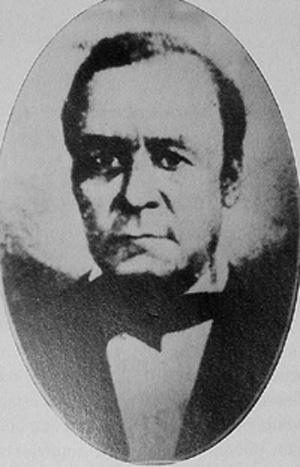
![]()
William C. Goodridge viii-- This freed son of a slave becomes became prominent in York county (PA) business in the decades before the Civil War, operating a major retail store in a 5 story structure that he built – the tallest in the region at that time. He uses his railroad cars to provide overground transit to slaves seeking freedom via the Underground Railroad. His son, Glenalvin Goodridge founded the longest running African-American photography in York, Pennsylvania, in 1847.ix Mural by Don & Jared Gray x
Toussaint L’Ouverture Grey
Toussaint L’Ouverture Grey was the first African-American child born in the city of St. Anthony in 1859.. His parents, Ralph and Emily Grey, moved to St. Anthony in the late 1850’s and they are the only known African-American Territorial Pioneers in Minnesota. Toussaint was named after Toussaint L’Ouverture, the African slave who liberated Haiti from the French in the late 1700’s. In August 1860, Ralph and Emily were major participants in the court case of Eliza Winston. Eliza was a slave of Colonel Christmas. Colonel Christmas had promised Eliza that she would be given her “free papers.” But he went back on his promise. Emily worked to get Eliza to a “safe house,” where she stayed until her case could be heard in court. Judge Charles Vandenberg granted Eliza her freedom, and she left Minnesota for Canada. Toussaint died at the age of nine and he is buried near his grandfather, William Goodridge, and his uncle, Glenalvin Goodridge.xi
John Cheatham, Fire Department Captain
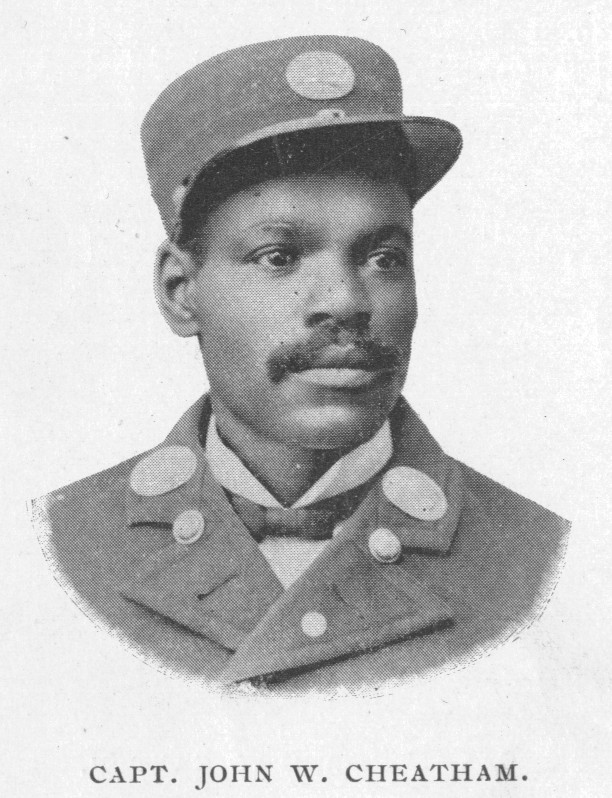
John Cheatham was born a slave in St. Louis, Missouri, on January 15, 1855. He was freed on January 1, 1863, when the Emancipation Proclamation went into effect. Mr. Cheatham was, if not the first African-American firefighter in Minneapolis, certainly one of the earliest. He had a distinguished career within the department, holding several positions of responsibility and receiving numerous promotions, ultimately becoming Captain in 1899.xii
Oscar Vaughn, Civil War veteran & the Battle of Nashville
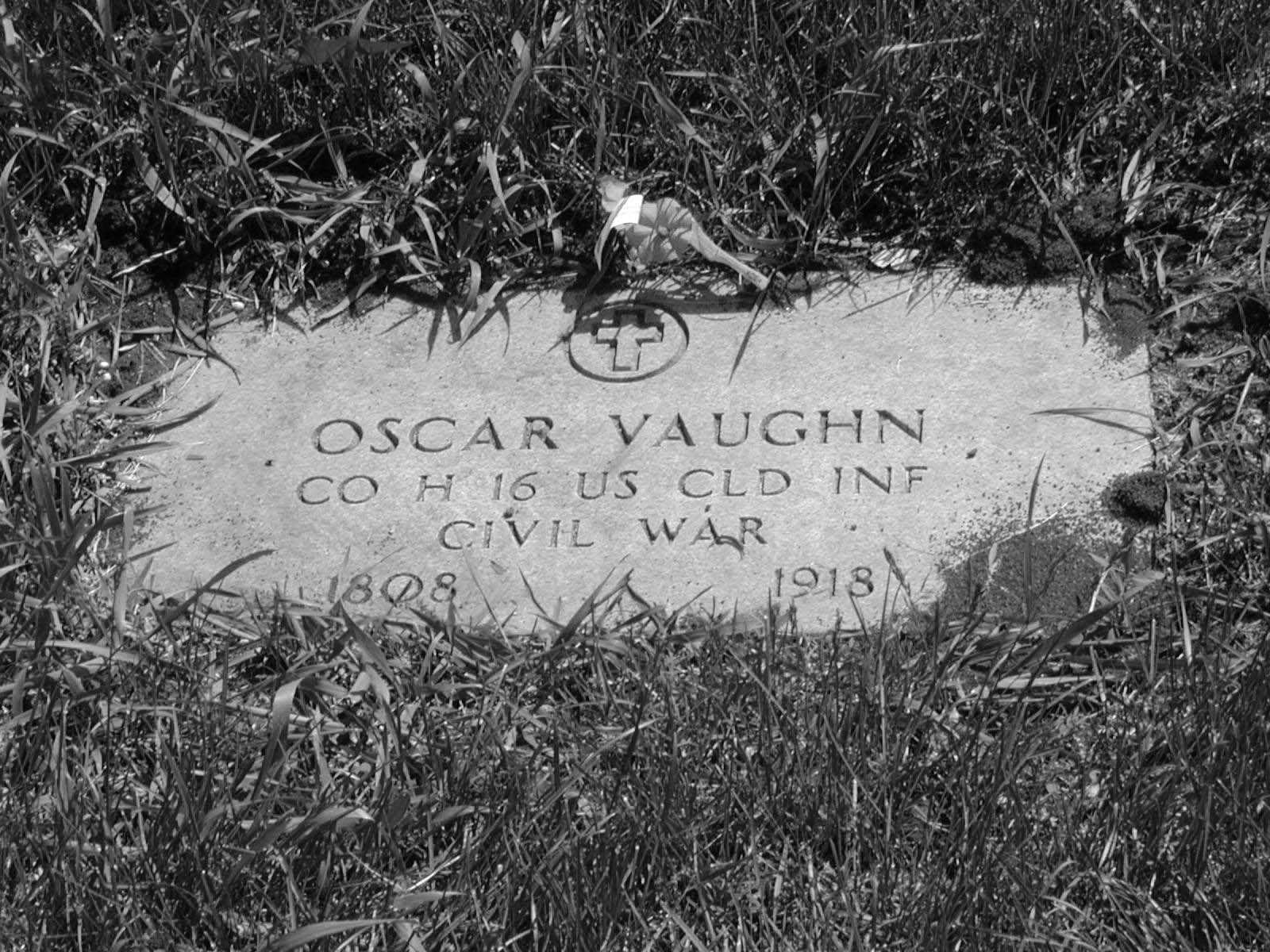

http://sablearm.blogspot.com/2010_12_01_archive.html
The best documented of theAfrican-American veterans buried in the cemetery is Oscar Vaughn. During the Civil War, Mr. Vaughn served as a private in Company H of the 16th U.S. Colored Infantry. The unit was involved in the Battle of Nashville in December 1864. The United States Colored Troops played an important part in this decisive Union victory. That any black troops were allowed to participate in this fight at all should not be taken lightly – Union commanders in the Western Theater (William Tecumseh Sherman being one of the most vociferous and influential among them) considered USCTs untrustworthy for front line service and tried to limit their service to nothing more than manual labor. When the fighting was over at Nashville, however, Maj. Gen. George Thomas was overheard to say, “Gentlemen, the question is settled; negroes will fight.”
In April 1898, Mr. Vaughn was one of 85 African-Americans who relocated from Kentucky to Fergus Falls, Minnesota, where they established a small farming community.xiii
Charles Collins
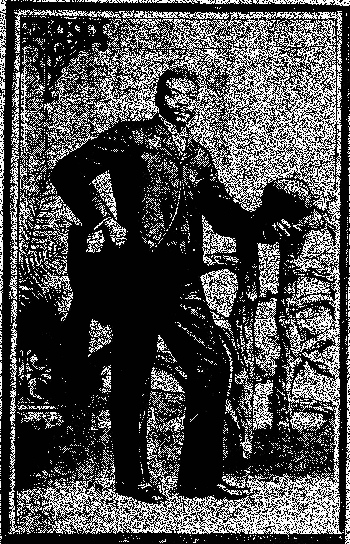
Charles Collins, an African American, was shot and killed by Herbert Gallehugh, a white man, on March 7, 1902. In an unusual move, members of the African-American community raised funds to hire an attorney to assist the government lawyers who were prosecuting the case. Herbert Gallehugh was convicted of 2nd degree murder, and sentenced to life at hard labor, and thus the African-American community received, in some small measure, the justice that they had sought for a valued member of their community. Charles Collins is buried in Lot 16, Block i-1 in Minneapolis Pioneers and Soldiers Memorial Cemetery.xiv
Another non-white person buried in the Pioneers and Soldiers Memorial Cemetery is Mary Prescott. Her birth name was Nah-he-no-wenah, or Spirit of the Moon. She was fully Native American of a Dakota sub-tribe but married a white trader by the name of Philander Prescott. Her husband as well as their son is buried beside her.
Prescott Monument
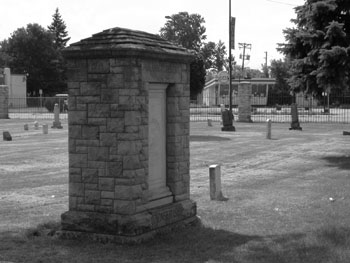
Mary Prescott is thought to have been born about 1804. Her father, Man Who Flies, was a subchief of the band of Dakotas who lived by Lake Calhoun. The name that was given by her family was Nah-he-no-wenah, or “Spirit of the Moon.” In 1823, Prescott approached Man Who Flies to ask for permission to marry his daughter. In keeping with the custom of the times, Prescott brought Mary's father gifts including ten blankets, a rifle, a pony, and five gallons of whiskey. Man Who Flies took three days to agree to the marriage but it took another ten days before Mary consented.
Mary was known to have understood French and English although she was only heard to speak Dakota. She was pictured as a gracious hostess, but one who always stood silently in the background. The marriage between Philander and Mary Prescott has been portrayed as one of the great romances of Minnesota territorial pioneer history, and in many ways it was. In his memoirs her husband, Philander Prescott, described her as a complex, resolute woman who remained close to her family and continued to share their values. Mary left him on at least one occasion over a disagreement about how to raise their bi-racial children in 1830's Minnesota. In turn, Philander left his wife and children and went South in search of business opportunities; two years later he returned to them. At a time when it was not uncommon for traders to live with, but later abandon, their Native American wives and children, Prescott observed, “Little did I think at that time that I should live with her until old age.” The Prescott's marriage lasted almost 40 years.
Philander Prescott was one of the casualties at the Lower Agency during the 1862 Dakota Conflict. When Minnesota became a state on May 11, 1858, representatives of several Dakota bands led by Little Crow traveled to Washington, D.C., to negotiate about enforcing existing treaties. The northern half of the reservation along the Minnesota River was lost. The ceded land was divided into townships and plots for settlement. Logging and agriculture on these plots eliminated surrounding forests and prairies, which interrupted the Dakota's annual cycle of farming, hunting, fishing and gathering wild rice. Hunting by settlers dramatically reduced wild game, such as bison, elk, whitetail deer and bear. Not only did this decrease the meat available for the Dakota in southern and western Minnesota, but it directly reduced their ability to sell furs to traders for additional supplies.xv In frustration the Dakota decided to attack settlements throughout the Minnesota River valley to try to drive whites out of the area. There has never been an official report on the number of settlers killed, but estimates range from 400 to 800. Philander Prescott’s remains were brought back to Minneapolis and buried in Minneapolis Pioneers and Soldiers Memorial Cemetery. After his death Mary moved to Shakopee to live with their daughter, Lucy Pettijohn. Mary died there on March 29, 1867. She was buried next to her husband and their son, Lorenzo Taliferro Prescott, a Civil War veteran.
End of the Dakota Conflict – Hanging of 38 convicted Sioux Indiansxvi
The notorious are also interred in this cemetery. Two of these people known in the Minneapolis area for their criminal records in the late 1800's and early 1900's were Harry Hayward and Della Stokes. After his hanging in 1895 for first-degree murder, Hayward's body was cremated in Chicago and his ashes returned to the Pioneers and Soldiers Memorial Cemetery to be buried. Della Stokes was thought by many to be a prostitute. It is known she was a petty thief and scam artist and the former was likely the reason Frank Stabbe murdered her in her room in October 1915. Spurned by her own family she was buried in the “pauper’s section” of the Layman Cemetery.
A final facet of the cemetery is of interest because of the importance that adoption had in Dorothy Womack’s adult life, as she had two beloved adopted daughters, Leslie and Jane. one of the saddest and most shocking stories related to the cemetery took place in 1909, when Dorothy Womack was a teenager. That was the year that Hans Oftedal, his wife, and Nurse Siegel abandoned Cody Hospital. They left behind five infants in the care of two teen-aged girls. The girls had no food or supplies for the babies, and one of Oftedal’s last acts before he left town was to order the gas company to turn off the utilities to the hospital.
The Cody Hospital was what was known at the time as a “baby farm.” Baby farms were commercial enterprises that handled the placement of children in foster or adoptive homes. In 1905, Minneapolis was known to have over 40 baby farms in operation, but city officials believed that the number had dropped to five by 1908.
The five children who were abandoned when the Oftedals left survived, but there are another 26 infants buried in Minneapolis Pioneers and Soldiers Cemetery who died at the Cody Hospital between May 1908 and August 1909.
Abandoned Infants
![“The babies [from the Baby Farm on Nicollet Avenue] are buried in unmarked graves at various locations throughout the cemetery.” This heart shaped grave marker is for Emma Bertta who died June 30th 1886, marker of a heart shaped cross and whose family did provide this marker.](http://alleynews.org/wp-content/uploads/2009/10/004.02-oct-09-tales-photoBabysMarker18861.jpg)
The abandoned children ranged in age from two days to one and a-half years old. They died from a variety of causes—prematurity, enterocolitis, and malnutrition to name a few. The children are buried in unmarked graves located in several sections of the cemetery, but primarily in Lots F, V and W.
The Layman family's association with the progressive Baptist church may explain why their privately-owned cemetery was never segregated, something that was almost unheard of it the 1850's and 60's. The mission the First German Baptist Church as stated in the 1880s was :
"To be obedient to Christ's commands by reaching up to build community with God through worship, reaching in to build community with one another through fellowship and discipleship and by reaching out to build community with neighborhoods and the world through service and evangelism."xvii
Martin and Elizabeth Layman lived this creed.
Layman's/Pioneers and Soldiers Memorial Cemetery is open for visitors from April 15 to October 15 and can be found at 2945 Cedar Avenue South where East Lake Street intersects the avenue.
By the 1880s a street car brought the public to the Cemetery
iii As listed in the proceedings and report of the annual meetings of the Minnesota Territorial Pioneers, May 11, 1899 and 1900.
xv Anderson, Gary and Alan Woolworth, editors. Through Dakota Eyes: Narrative Accounts of the Minnesota Indian War of 1862, Minnesota Historical Society Press (1988). ISBN 0-87351-216-2
Views: 1196
Comment
© 2025 Created by IIGS Ex Director.
Powered by
![]()
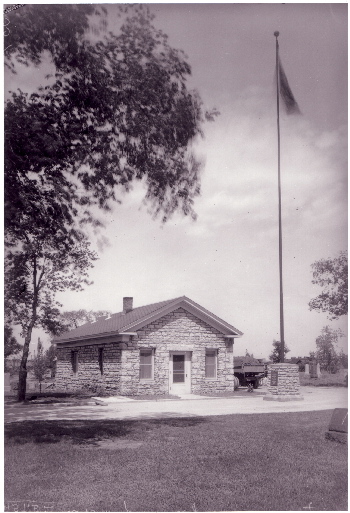
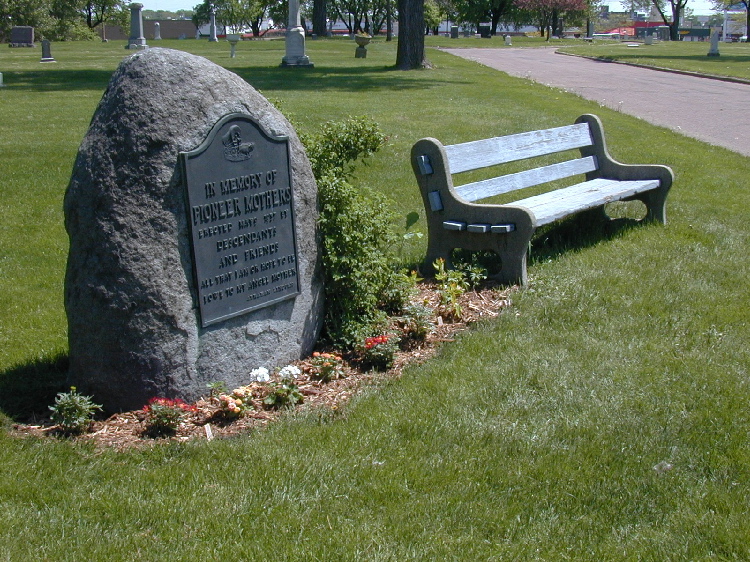
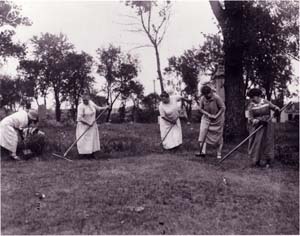
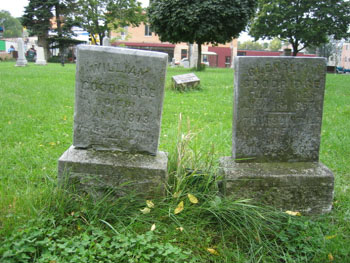
You need to be a member of Genealogy Social to add comments!
Join Genealogy Social